Description
Kathryn J. Tomlin
Ages: 16AdultGrades: 11-Adult
Clients focus on their strengths to identify memory strategies that work, then practice and apply their memory strategies to new contexts.
Written in the best-selling format of the Workbook of Activities for Language and Cognition series, these activities have:
- easy-to-read format
- simple, concise language
- consistent progression of complexity within and between tasks
- application to a wide range of acquired cognitive-language disorders
WALC 10 Memory begins with a series of activities to determine the client's dominant coding system (visual, auditory, and kinesthetic). Clients recognize memory strategies they already use and the value of learning new ones. The rest of the book focuses on learning and practicing memory strategies. The lessons are organized by these memory strategies:
- Word/Mental Picture AssociationsRecall information using associations such as part/whole, category, action/agent (e.g., wrapping/present), attributes, and location.
- Chaining Word ListsCreate chains of word associations and recall lists of information.
- Following Written and Oral DirectionsFollow two- and three-step directions. Make mental images of what the directions request and then carry them out.
- Recalling Boxed InformationClients study the placement of shapes, numbers, and words in boxes and code it for later recall.
- First Letter MnemonicsTake the first letter of each word in a list of words and create a new word from those letters.
- Word List RetentionClients develop mental flexibility as they practice memory strategies with the added factors of inclusion (e.g., Which words were first and last in the list?) and exclusion (e.g., Which ones are not soft?).
- Associated Visual PairsAssociate two visual items and then recall one of the items using a memory/coding strategy.
- Name-Picture AssociationClients practice coding people's names to their faces.
- Memory for Numbers and SentencesLearn strategies for recalling number sequences and lengthy sentences.
- Picture AssociationDevelop associations between objects, between people and objects, and between people and places.
- Memory for Shapes and PicturesClients use various memory strategies to name, duplicate, and answer questions about shapes and pictures.
- Sorting and Remembering CategoriesCode and recall words and pictured items by creating categories for them.
- Functional Memory TasksRead or listen to messages, directions, paragraphs, and informative articles and recall pertinent information.
- Memory and Mental ManipulationClients remember words and repeat them back in a variety of ways including backwards, alphabetically, in order of size, etc.
E-Book Features and Benefits
- Accessible from any device with Internet access
- Search and find using keywords
- Add notes and bookmarks as you read
To see more of this product's contents:
186 pages e-book 2006














